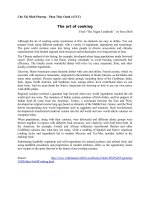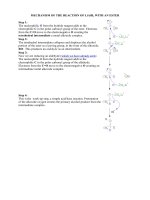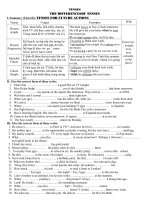The principal of consolidation
Bạn đang xem bản rút gọn của tài liệu. Xem và tải ngay bản đầy đủ của tài liệu tại đây (1.11 MB, 131 trang )
Chapter 1
The principles of
consolidation
Learning objectives
Reference
Consolidated financial statements
LO6
Discuss the forms of business combinations
LO6.1
Explain the concept of control and how the existence of
control is determined
LO6.4
Explain why transactions within a group must be
eliminated
Equity accounting
LO6.6
Define 'significant influence' and briefly analyse the
factors that may be used to determine whether
significant influence exists
LO7.1
LO7
Topic list
1
2
3
4
Group accounts – an introduction
Group companies
IAS 27 Consolidated and separate financial statements
Intra-group transactions
193
Introduction
Consolidation is an extremely important area of your studies.
The key to consolidation questions in the examination is to adopt a logical
approach and to practise as many questions as possible.
In this chapter we will look at the major definitions in consolidation. These matters are
fundamental to your comprehension of group accounts, so make sure you can
understand them and then learn them.
194
Financial Accounting and Reporting
Before you begin
If you have studied these topics before, you may wonder whether you need to study
this chapter in full. If this is the case, please attempt the questions below, which cover
some of the key subjects in the area.
If you answer all these questions successfully, you probably have a reasonably detailed
knowledge of the subject matter, but you should still skim through the chapter to
ensure that you are familiar with everything covered.
There are references in brackets indicating where in the chapter you can find the
information, and you will also find a commentary at the back of the Study Manual.
1
What is a subsidiary?
(Section 2.1)
2
What is an associate?
(Section 2.1)
3
How is control established?
(Section 2.2)
4
How is significant influence established?
(Section 2.3)
5
How are a subsidiary and an associate accounted for?
6
Which subsidiaries may be excluded from a consolidation?
(Section 2)
(Section 3.4)
10: The principles of
consolidation
195
1 Group accounts – an
introduction
Section overview
•
Many large businesses consist of several companies controlled by one central or
administrative company. Together these companies are called a group. The
controlling company, called the parent or holding company, will own some or
all of the shares in the other companies, referred to as subsidiaries.
Introduction
There are many reasons for one company to buy all or part of another: for the goodwill
associated with the names of the subsidiaries, for tax or legal purposes and so forth. In
many cases, one company will grow by acquisition and so buy a number of other
companies.
In traditional accounting terminology, a group of companies consists of a parent
company and one or more subsidiary companies that are controlled by the parent
company. These terms are defined in more detail in Section 2 of this chapter.
The need for group accounts
The information contained in the individual financial statements of a parent company
and each of its subsidiaries does not give a picture of the group's total activities.
Equally, where a group has a number of subsidiaries, users of the accounts will be
unable to obtain an understanding of the overall position and performance of the
group simply by looking at the numerous financial statements of the individual
companies that make up the group.
Therefore, group accounts must be prepared from the individual financial
statements.
Consolidated accounts are a form of group accounts which combines the
information contained in the separate accounts of a holding company and its
subsidiaries as if they were the accounts of a single entity. 'Group accounts' and
'consolidated accounts' are terms often used synonymously.
Most parent companies present their own individual accounts and their group accounts
in a single package. The package typically comprises the following:
•
•
Parent company financial statements, which will include 'investments in
subsidiaries' as an asset in the statement of financial position, and income from
subsidiaries (dividends) in the statement of comprehensive income
Consolidated statement of financial position
•
Consolidated statement of comprehensive income
•
Consolidated statement of cash flows.
It may not be necessary to publish all of the parent company's financial statements,
depending on local or national regulations.
Accounting standards
We will be discussing three accounting Standards in this and the next three
chapters:
•
IAS 27 Consolidated and separate financial statements
•
IFRS 3 Business combinations
•
IAS 28 Investments in associates.
These standards are all concerned with different aspects of group accounts, but there
is some overlap between them, particularly between IFRS 3 and IAS 27.
In this and the next chapter we will concentrate on IAS 27, which covers the basic
group definitions and consolidation procedures of a parent-subsidiary relationship. First
of all, however, we will consider all the important definitions involved in group
accounts, which determine how to treat each particular type of investment in
group accounts.
196
Financial Accounting and Reporting
LO
6.
1
2 Group companies
Section overview
•
A subsidiary is an entity that is controlled by another entity, its parent.
Control can usually be assumed to exist when the parent owns over 50% of
the voting power of an entity.
Definitions
We will look at some of these definitions in more detail later, but they are useful here
in that they give you an overview of all aspects of group accounts.
Exam comments
All the definitions relating to group accounts are extremely important. You must learn
them and
understand their meaning and application.
Definitions
•
Control. The power to govern the financial and operating policies of an entity so
as to obtain benefits from its activities.
(IFRS 3, IASs
27, 28)
•
Subsidiary. An entity that is controlled by another entity (known as the parent). (IFRS 3, IASs
27, 28)
•
Parent. An entity that has one or more subsidiaries.
•
Group. A parent and all its subsidiaries.
•
Associate. An entity, including an unincorporated entity such as a partnership,
in which an investor has significant influence and which is neither a subsidiary
nor a joint venture of the investor. (IAS 28)
•
Significant influence is the power to participate in the financial and operating
policy decisions of an investee or an economic activity but is not control or joint
control over those policies.
(IAS
28)
(IFRS 3, IAS 27)
(IAS 27)
We can summarise the different types of investment and the required accounting for
them as follows:
Investment
Criteria
Subsidiary
Control
Required treatment in group
accounts
Full consolidation
Associate
Significant influence
Equity accounting (see Chapter 13)
Investment which is
none of the above
Asset held for
accretion of wealth
As for single company accounts
Investments in subsidiaries
LO
6.
4
The important point here is control. In most cases, this will involve the holding
company or parent owning a majority of the ordinary shares in the subsidiary (to which
normal voting rights are attached). There are circumstances, however, when the
parent may own only a minority of the voting power in the subsidiary, but the parent
still has control.
IAS 27 states that control can usually be assumed to exist when the parent owns
more than half (i.e. over 50%) of the voting power of an entity unless it can be
clearly shown that such ownership does not constitute control (these situations
will be very rare).
10: The principles of
consolidation
197
What about situations where this ownership criterion does not exist? IAS 27 lists the
following situations where control exists, even when the parent owns only 50% or less
of the voting power of an entity:
(a)
The parent has power over more than 50% of the voting rights by virtue of
agreement with other investors.
(b)
The parent has power to govern the financial and operating policies of the
entity by statute or under an agreement.
(c)
The parent has the power to appoint or remove a majority of members of the
board of directors (or equivalent governing body).
(d)
The parent has power to cast a majority of votes at meetings of the board of directors.
IAS 27 also states that a parent loses control when it loses the power to govern the
financial and operating policies of an investee. Loss of control can occur without a
change in ownership levels. This may happen if a subsidiary becomes subject to the
control of a government, court administrator or regulator (for example, in bankruptcy).
2.2.1 Accounting treatment in group accounts
IAS 27 requires a parent to present consolidated financial statements, in which the
accounts of the parent and subsidiary (or subsidiaries) are combined and presented as
a single entity.
Investments in associates
LO
7.
1
This type of investment is something less than a subsidiary, but more than a
simple investment. The key criterion here is significant influence. This is defined
as the 'power to participate', but not to 'control' (which would make the investment
a subsidiary).
Significant influence can be determined by the holding of voting rights (usually
attached to shares) in the entity. IAS 28 states that if an investor holds 20% or more
of the voting power of the investee, it can be presumed that the investor has
significant influence over the investee, unless it can be clearly shown that this is not
the case.
Significant influence can be presumed not to exist if the investor holds less than
20% of the voting power of the investee, unless it can be demonstrated otherwise.
The existence of significant influence is evidenced in one or more of the
following ways:
(a)
Representation on the board of directors (or equivalent) of the investee
(b)
Participation in the policy making process
(c)
Material transactions between investor and investee
(d)
Interchange of management personnel
(e)
Provision of essential technical information.
2.3.1 Accounting treatment in group accounts
IAS 28 requires the use of the equity method of accounting for investments in
associates. This method will be explained in detail in Chapter 13.
Question 1: Treatments
The section summary after this question will give an augmented version of the table
given in Paragraph 2.1 above. Before you look at it, see if you can write out the table
yourself.
(The answer is at the end of the chapter)
198
Financial Accounting and Reporting
2.4 Section summary
Investment
accounts
Subsidiary
Associate
28)
Investment
which is none of
the above
3
Criteria
Required treatment in group
Control (> 50% rule)
Full consolidation (IAS 27)
Significant influence (20%+ rule)
Equity accounting (IAS
Asset held for
accretion of wealth
As for single company accounts
IAS 27 Consolidated and separate financial
statements
Section overview
•
IAS 27 requires a parent to present consolidated financial statements.
Introduction
Definition
Consolidated financial statements. The financial statements of a group presented
as those of a single economic entity.
(IAS
27)
When a parent issues consolidated financial statements, it should consolidate all
subsidiaries, both foreign and domestic. IAS 27 provides guidance on the mechanics
of consolidation including exemptions from consolidation, the use of uniform
accounting policies, matching reporting dates and the elimination of intra- group
transactions.
Exemption from preparing group accounts
A parent need not present consolidated financial statements if and only if all of the
following hold:
(a)
The parent is itself a wholly-owned subsidiary or it is a partially owned
subsidiary of another entity and its other owners, including those not
otherwise entitled to vote, have been informed about, and do not object to, the
parent not presenting consolidated financial statements
(b)
Its securities are not publicly traded
(c)
It is not in the process of issuing securities in public securities markets; and
(d)
The ultimate or intermediate parent publishes consolidated financial
statements that comply with International Financial Reporting Standards.
A parent that does not present consolidated financial statements must comply with the
IAS 27 rules on separate financial statements (discussed later in this section).
Potential voting rights
An entity may own share warrants, share call options, or other similar instruments that
are convertible into ordinary shares in another entity. If these are exercised or
converted they may give the entity voting power or reduce another party's voting
power over the financial and operating policies of the other entity (potential voting
rights). The existence and effect of potential voting rights, including potential voting
rights held by another entity, should be considered when assessing whether an entity
has control over another entity (and therefore has a subsidiary).
In assessing whether potential voting rights give rise to control, the entity
examines all facts and circumstances that affect the rights (for example,
terms and conditions), except the intention of management and the financial
ability to exercise the rights or convert them into equity shares.
10: The principles of
consolidation
199
Exclusion of a subsidiary from consolidation
The rules on exclusion of subsidiaries from consolidation are necessarily strict, because
this is a common method used by entities to manipulate their results. If a subsidiary
which carries a large amount of debt can be excluded, then the gearing of the group as
a whole will be improved. In other words, this is a way of taking debt out of the
statement of financial position.
IAS 27 did originally allow a subsidiary to be excluded from consolidation where
control is intended to be temporary. This exclusion was then removed by IFRS 5.
Subsidiaries held for sale are accounted for in accordance with IFRS 5 Non-current
assets held for sale and discontinued operations rather than consolidated under IAS
27. IFRS 5 does not form part of the Financial Accounting and Reporting syllabus.
It has been argued in the past that subsidiaries should be excluded from consolidation
on the grounds of dissimilar activities, i.e. the activities of the subsidiary are so
different to the activities of the other companies within the group that to include its
results in the consolidation would be misleading. IAS 27 rejects this argument:
exclusion on these grounds is not justified because better (relevant) information can be
provided about such subsidiaries by consolidating their results and then giving
additional information about the different business activities of the subsidiary.
The previous version of IAS 27 permitted exclusion where the subsidiary operates
under severe long- term restrictions and these significantly impair its ability to
transfer funds to the parent. This exclusion has now been removed. Control must
actually be lost for exclusion to occur.
Different reporting dates
In most cases, all group companies will prepare accounts to the same reporting date.
One or more subsidiaries may, however, prepare accounts to a different reporting date
from the parent and the bulk of other subsidiaries in the group.
In such cases the subsidiary may prepare additional statements to the reporting date
of the rest of the group, for consolidation purposes. If this is not possible, the
subsidiary's accounts may still be used for the consolidation, provided that the gap
between the reporting dates is three months or less.
Where a subsidiary's accounts are drawn up to a different accounting date,
adjustments should be made for the effects of significant transactions or
other events that occur between that date and the parent's reporting date.
Uniform accounting policies
Consolidated financial statements should be prepared using the same accounting
policies for like transactions and other events in similar circumstances.
Adjustments must be made where members of a group use different accounting
policies, so that their financial statements are suitable for consolidation.
Date of inclusion or exclusion
The results of subsidiaries are included in the consolidated financial
statements from:
(a)
The date of 'acquisition', i.e. the date control passes to the parent, to
(b)
The date of 'disposal', i.e. the date control passes from the parent.
Once an investment is no longer a subsidiary, it should be treated as an
associate under IAS 28 (if applicable) or as an investment under IAS 39
(outside the scope of the Financial Accounting and Reporting syllabus).
200
Financial Accounting and Reporting
Accounting for subsidiaries and associates in the parent's
separate financial statements
A parent company will usually produce its own single company financial statements. In
these statements, investments in subsidiaries and associates included in the
consolidated financial statements should be either:
(a)
Accounted for at cost, or
(b)
In accordance with IAS 39 (outside the scope of the Financial Accounting and Reporting
syllabus).
4 Intra-group transactions
Section overview
•
LO
6.
6
It is common for parent companies to transact with their subsidiaries. These
transactions should not be reflected in the consolidated accounts.
One of the reasons why groups grow and companies acquire other companies is
vertical integration. In other words, a company acquires its suppliers or customers.
Therefore, it follows that intra-group or intercompany transactions are commonplace
within group scenarios. One group company may sell goods to another, or it may be
that one company provides funding for others. Equally, where a subsidiary pays a
dividend to its shareholders, some, or all of this amount is due to the parent
company.
These transactions between group companies are (quite rightly) represented in the
companies’ individual accounts. When considering the group accounts, however, it
must be remembered that they aim to present the group as a single economic entity.
One entity is unable to trade with itself or lend to itself, and therefore the effects of
intra-group transactions must be eliminated on consolidation. The mechanics of this
are covered in the following two chapters.
The net result is that the group accounts only include the effects of transactions
between the group companies and third parties outside the group.
10: The principles of
consolidation
201
Key chapter points
•
The parent or holding company of a group owns some or all of the shares in the other
companies.
•
The information contained in the individual financial statements of a parent
company and each of its investee companies does not give a picture of the
group's total activities. Therefore, group accounts must be prepared from the
individual ones.
•
A subsidiary is an entity that is controlled by the parent company. Control can
usually be assumed to exist when the parent owns over 50% of the voting power
of an entity.
•
Subsidiaries are consolidated in the group financial statements.
•
A parent company has significant influence over an associate. Significant
influence is normally assumed to exist where the parent owns at least
20% of the voting power of an entity.
•
Associates are equity accounted within the group financial statements.
•
Where a parent company has neither control nor significant influence over an
investee, the investment is recognised in group accounts in the same way as
in the parent’s individual accounts.
•
Subsidiaries may only be excluded from consolidation if they are held for sale or control is lost.
•
Consolidated financial statements should be prepared from parent and
subsidiary accounts prepared to the same reporting date. If this is not possible,
the subsidiary's accounts may still be used for the consolidation, provided that
the gap between the reporting dates is three months or less.
•
Consolidated financial statements should be prepared from parent and
subsidiary accounts which use the same accounting policies for like transactions
and other events in similar circumstances.
•
It is common for parent companies to transact with their subsidiaries. These
transactions should not be reflected in the consolidated accounts.
202
Financial Accounting and Reporting
Quick revision questions
1
During the last three years Harvert Co had held 400 000 ordinary shares in
Jamee Co. The issued share capital of Jamee Co is $500 000 in shares of 50c
each. The finance director of Harvert Co is a director of Jamee Co.
How should the investment in Jamee Co be treated in the consolidated financial
statements of Harvert Co?
A
as a non-current asset
investment B
as a current
asset investment
C
as an associate
D
as a subsidiary
2
A owns 51% of the voting shares in B and 100% of the voting shares in D. B
owns 25% of the voting shares in C and has board representation in that
company.
All holdings have been held for a
number of years. Which of the following
statements is correct?
A
B, C and D are subsidiaries of A
B
B and D are subsidiaries of A while C is an
associate of B C
B and D are subsidiaries of A
while C is a subsidiary of B D
D is a subsidiary
of A while B and C are investments of A
3
4
Which one of the following is a valid reason for excluding a 75% owned company
from consolidation under current International Financial Reporting Standards?
A
the company operates in a country where the government has recently
passed a law to obtain the power to govern the financial and operating
policies of all entities
B
the activities of the company are so dissimilar from those of the rest of
the group that it would be misleading to include it in the consolidation
C
a formally documented decision has been made by the directors to wind
down the activities of the company
D
the company operates in a hyperinflationary environment
Which of the following provide evidence of a parent-subsidiary relationship?
I
The parent has power over more than 50% of the voting rights through
agreement with other investors
II
The parent has power to govern the financial and operating policies of
the entity by statute III
The parent has the power to remove a majority of
members of the board of directors
IV
The parent has representation on the board of
directors
A
B
C
D
5
I only
I and IV only
I, II and III only
I, II, III and IV
During the last financial year, Orius Co acquired 44% of the issued share capital
of Eerus Co. Under the terms of the acquisition, the finance director of Orius was
appointed to the board of directors of Eerus.
Which of the following correctly describes how Orius should account for its
interest in Eerus in the consolidated financial statements?
A
as a subsidiary, using consolidation
accounting B
as a subsidiary, using
equity accounting
C
as an associate, using consolidation
accounting D
as an associate, using
equity accounting
10: The principles of
consolidation
203
6
Which of the following provides evidence of a situation where the investee
should be accounted for using the equity method?
A
provision of essential technical information by the parent
to the investee B a shareholding of 18% in the investee
C
provision of operational personnel by the parent to the investee
D
the parent has the power to govern the financial policies of the investee by agreement
7
Where a subsidiary does not prepare accounts to the same date as the parent
company, which of the following is true?
A
the subsidiary’s accounts may be used for the consolidation provided that
they are prepared to a date within three months before the end of the
group reporting period
B
the subsidiary’s accounts may be used for the consolidation provided that
they are prepared to a date within three months after the end of the
group reporting period
C
additional financial statements must be prepared to the group reporting
date by the subsidiary D the subsidiary’s accounts may be used for the
consolidation provided that the gap between
the reporting dates is three months or less
8
Which of the following statements are true?
I
Intra-group transactions must be eliminated on consolidation
II
A holding of 10% of ordinary voting shares in another company is
accounted for in accordance with IAS 27 Consolidated and
separate financial statements
III
Where a subsidiary does not adopt the same accounting policies as its
parent company, adjustments must be made to bring its accounting
policies into line prior to consolidation
IV
Where a group comprises a parent company and an investee over
which the parent has significant influence, consolidated accounts
must be prepared
A
B
C
D
I and III only
I and IV only
II and III only
I, II, III and IV
204
Financial Accounting and Reporting
Answers to quick revision
questions
1
C
=
Shareholding in Jamee
400 000
shares
1000 000
shares
= 40%
With such a shareholding and with one director on the board of Jamee it is
likely that Harvert has significant influence over the operating and financial
policies of Jamee (although not control).
Therefore, this investment would be treated as an associate in the
consolidated financial statements of Harvert.
2
B
A controls B and D as a result of holding the majority of the shares in
each company, therefore they are subsidiaries. B has significant
influence over C and therefore C is an associate of B. C is not controlled
by A or B and is therefore not a subsidiary of either of these companies.
3
A
The company is no longer controlled; the laws passed by the government
transfer control to the state from the majority shareholder.
4
C
Representation of the parent on the board of directors of the
investee is evidence of significant influence rather than dominant
influence or control.
5
D
With a shareholding of 44% it would not appear that Orius has control of
Eerus but particularly with representation on the board of directors it
does seem to exert significant influence. Therefore, Eerus would be
treated as an associate using equity accounting.
6
A
An associate is accounted for using the equity method. An associate relationship is
presumed where the holding of ordinary voting shares is at least 20%, so
the answer is not B. A further indicator of an associate relationship is the
provision of management personnel – not simply operational personnel,
hence not C. Where the parent has the power to govern the financial
policies of the investee by agreement, this is evidence of a parentsubsidiary relationship.
7
D
A subsidiary need not prepare accounts to the same date as the parent
company in order for them to be consolidated, however the subsidiary’s
reporting date should be within three months either side of the group
reporting date.
8
A
Consolidated accounts are only prepared where there is at least one
subsidiary. Where there is no subsidiary but a parent has significant
influence over an investee then that investee is recognised in the parent
company’s accounts in accordance with IFRS 9, but consolidated accounts
are not prepared.
10: The principles of
consolidation
205
Answer to chapter question
1
Investment
accounts
Subsidiary
Associa
te
Investment
which is none of
the above
206
Criteria
Required treatment in group
Control (> 50% rule)
Full consolidation (IAS 27)
Significant influence
(20%+
rule)
Asset held for
accretion of wealth
Equity accounting
(IAS 28)
Financial Accounting and Reporting
As for single company accounts









